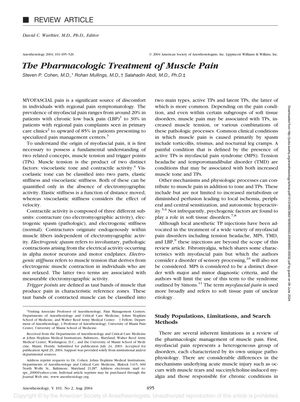The Pharmacologic Treatment of Muscle Pain
July 2004
in “
Anesthesiology
”

TLDR The document concludes that more research is needed to understand how to treat muscle pain with drugs.
The 2004 document reviews the effectiveness of pharmacologic treatments for muscle pain, particularly myofascial pain. It discusses the role of muscle tension, trigger points, and various causes of muscle pain, including metabolic, perfusion, sensitization, autonomic, and psychogenic factors. The paper highlights the challenges in studying the pharmacologic management of muscle pain due to the diversity of disorders and the wide range of drugs used. It emphasizes that drug treatment should complement a multimodal therapeutic approach. The document provides an evidence-based classification for the efficacy of different drug classes, noting strong evidence for tricyclic antidepressants (TCAs) in treating tension-type headaches and facial pain/temporomandibular disorder (TMD), but limited evidence for anticonvulsants. Skeletal muscle relaxants like cyclobenzaprine and tizanidine have shown effectiveness in relieving muscle spasm and pain in certain conditions, while the evidence for other treatments, such as 5-HT agonists and sympathetic blocking agents, is limited or conflicting. The paper concludes that further research is necessary to fully understand the pharmacologic treatment of muscle pain.